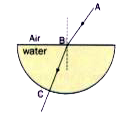A mixture of oxygen and ethyne is burnt for welding. Can you tell why a mixture of ethyne and air is not used?
Step-by-Step Solution:
1. Understanding Combustion: When ethyne (C₂H₂) is burned, it reacts with oxygen to produce heat and light. This process is known as combustion.
2. Types of Combustion: There are two types of combustion:
- Complete Combustion: This occurs when there is a sufficient supply of oxygen, resulting in the complete conversion of ethyne to carbon dioxide (CO₂) and water (H₂O). This type of combustion produces a clean flame.
- Incomplete Combustion: This occurs when there is a limited supply of oxygen, leading to the formation of carbon monoxide (CO) and soot (carbon particles). This type of combustion produces a sooty flame.
3. Ethyne and Air: Air contains only about 21% oxygen. When ethyne is burned in air, the limited oxygen supply leads to incomplete combustion, resulting in a sooty flame.
4. Ethyne and Oxygen: In contrast, when ethyne is burned in pure oxygen, there is an abundant supply of oxygen, allowing for complete combustion. This produces a clean flame and generates a much higher temperature.
5. Temperature Consideration: The temperature achieved during the combustion of ethyne in pure oxygen can reach up to 3,000 degrees Celsius, which is necessary for welding. This high temperature cannot be achieved when burning ethyne in air due to the limited oxygen supply.
6. Conclusion: Therefore, a mixture of ethyne and oxygen is preferred for welding instead of a mixture of ethyne and air because it ensures complete combustion, produces a clean flame, and reaches the high temperatures required for effective welding.
---
- Complete Combustion: This occurs when there is a sufficient supply of oxygen, resulting in the complete conversion of ethyne to carbon dioxide (CO₂) and water (H₂O). This type of combustion produces a clean flame.
- Incomplete Combustion: This occurs when there is a limited supply of oxygen, leading to the formation of carbon monoxide (CO) and soot (carbon particles). This type of combustion produces a sooty flame.
Topper's Solved these Questions
Similar Questions
A mixture of acetone and methanol can be separated by
View SolutionIn Fig. A, can you tell why there is no refraction at C.

View SolutionBordeaux used a fungicide is a mixture of
View SolutionCS2 can separate a mixture of
View Solution30mL mixture of ethylene and Butylene is burnt in presence of oxygen then 150mL of oxygen is required, what is the volume of Ethylene & Butylene in mixture.
View SolutionWhy is tap water a mixture ?
View SolutionTo separate a mixture of monosacharides, you would use
View SolutionIs air a mixture or a compound?
View SolutionCarbon dioxide is a mixture of carbon and oxygen.
View SolutionWhich mixture is lighter than humid air ?
View Solution
